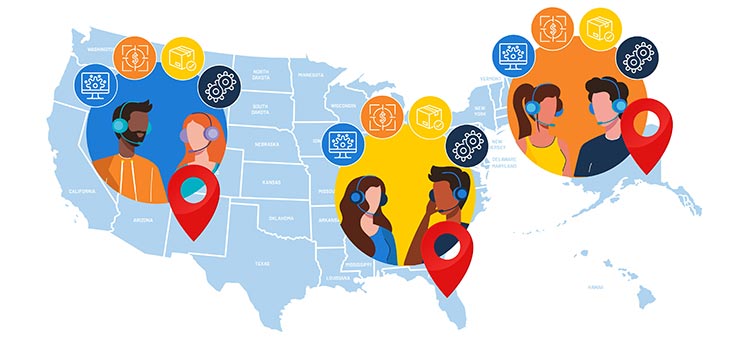Call Center Agent Structure
Call center agent structure plays a vital role in delivering great customer service and high First Call Resolution (FCR). Most call centers have a generalized structure (e.g., agents handle multiple contact channels and/or multiple call types) versus a specialized structure (e.g., agents handle specific contact channels and/or specific call types).
There has also been a movement towards a universal super-agent structure (e.g., agents handle most or all contact channels and call types). This movement has good intentions because many call center managers believe universal super-agents can handle and resolve most call types.

Also, many call center leaders believe that customer satisfaction (Csat) will improve because the generalist or super-agent can handle most customer inquiries or problems. Put differently, the customer does not have to talk to multiple agents to resolve their call.
The difference between a generalized versus a super-agent call center structure is that a super-agent handles any call or contact type. In contrast, the generalized agent handles most call and contact types.
Furthermore, many call center managers believe that the other advantage of the generalist and universal super-agent structure is having a larger labor pool of agents to handle more call types without increasing headcount.
However, even though service levels can improve, SQM research shows very few call centers improve their FCR and Csat performance by moving from a specialized structure to a universal super-agent structure. Moreover, SQM’s research shows that FCR and Csat can drop by 5% to 15% with a universal super-agent structure.
It is not uncommon for call centers that have attempted to use the universal super-agent structure to have returned to the specialized or generalized structure. Another common call center agent structure involves handling service, and sales call types. Many customers and call centers have benefited from focusing on an add-on or cross-sell sales approach.
It is not uncommon for the revenue generated from the call center’s add-on or cross-sell sales to cover the budget expenses at a minimum. Call centers that do the best job at add-on sales “earn the right to sell” to customers, and their sales approach is based on customers’ needs versus the organizations’ needs.
The “earning the right to sell” approach resolves the customer’s call before offering a sale based on their needs. SQM’s experience has shown that agents see this approach as a better way to service customers. In other words, when the “earn the right to sell” approach, agents tend to view selling as servicing customers. However, when the call center uses an organizational needs selling approach, most customer service-orientated agents feel uncomfortable selling.
SQM’s opinion is that an agent’s profile who predominantly provides customer service with add-on sales is different from an agent who predominantly does selling with some servicing. Therefore, when the call center focuses on selling, the call center should be structured by separating service and selling functions.
SQM’s research shows that when a call center does not separate service and sales functions, especially when it focuses on selling, their FCR and Csat can go down by 5% to 15%. It is essential to mention that SQM has clients that have separated the sales function from the service function and, in doing so, have turned their call center sales function from a cost center to a profit center.
Most call centers that SQM works with and have multiple locations use a redundancy approach, meaning that all call centers handle the same call types. The significant advantage of that approach is that calls can be routed to a different call center location, and business can be continued if a disaster occurs

Another advantage of redundancy is that if a call center has technical issues or a meeting with some or all of the agents, the calls can be routed to a different call center location. These are all good reasons for creating redundancy when you have multiple call center locations.
However, it is SQM’s view that call centers should specialize in handling certain call types where they can. The agent specialization structure can potentially increase your FCR and Csat performance by 5% to 15%. The downside of the specialization structure is that you have less redundancy available should the call center go down for technical, operational, or disaster reasons. For example, if you had four call centers, two of the four would handle the same call types versus all four handling the same call types.
Quick Related Links
First Call Resolution Definition First Call Resolution PPT First Call Resolution Benefits First Call Resolution Strategies First Call Resolution Operating Philosophy FCR Case Study Agent Working from Home Cost Per Call Resolution Call Complexity Channel Volume Call Length Internal FCR Agent Average Length of Service Pended for Resolution Customer Quality Assurance Agent Call Handling
